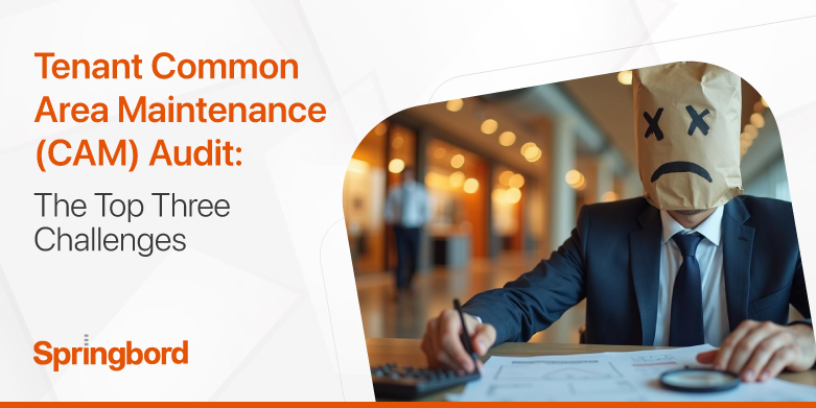 Read time 4 min
Read time 4 minIntroduction
Common Area Maintenance (CAM) charges are a fundamental aspect of commercial lease agreements, ensuring shared spaces are maintained and operational costs are fairly distributed among tenants. However, 30% of CAM reconciliations contain errors, leading to financial discrepancies and disputes between landlords and tenants according to the Journal of Property Management. Professional CAM audit services can help identify and correct these errors, ensuring accuracy and compliance with lease terms.
For tenants, conducting an accurate CAM audit is essential to prevent overpayments and ensure landlords adhere to lease agreements. However, CAM audits present several challenges, from ambiguous lease terms to discrepancies in reconciliations and a lack of transparency in expense allocations. These challenges, if left unaddressed, can result in substantial financial losses and legal conflicts.
This article explores the top three challenges affecting CAM audits for tenants, shedding light on their financial implications and offering insights into best practices to navigate them effectively.
1. Lack of Transparency in CAM Reconciliations
The Challenge
One of the biggest hurdles tenants face is the lack of transparency in CAM reconciliations. Landlords are responsible for itemizing expenses and allocating costs fairly, but many reconciliation statements are unclear, inconsistent, or incomplete.
A study by The National Real Estate Investor found that 40% of CAM-related disputes arise due to unclear reconciliation statements and misclassified expenses. Without detailed breakdowns, tenants cannot verify whether they are being charged correctly or if expenses adhere to lease agreements.
Common Transparency Issues in CAM Audits
- Missing or vague expense details: Reconciliation statements often lack itemized breakdowns of charges, making it difficult to assess their validity.
- Incorrect expense categorization: Some landlords misclassify capital expenditures as operating expenses, leading to higher tenant contributions.
- Undocumented administrative fees: Many landlords include hidden administrative or management fees without proper justification.
Impact on Tenants
Without full disclosure of cost breakdowns, tenants have little control over what they are paying and may unknowingly overpay thousands of dollars annually. A lack of transparency also hinders negotiations, as tenants lack the necessary data to dispute excessive charges.
Springbord’s Solution
Springbord specializes in CAM reconciliation audits, ensuring tenants receive detailed, transparent reports outlining all CAM charges. Our audit process verifies expense classifications, ensures exclusions are honored, and highlights discrepancies, giving tenants the insights they need to dispute unfair charges effectively.
2. Lease Agreement Misinterpretations
The Challenge
A major contributor to CAM errors is the misinterpretation of lease agreements. CAM charges vary based on lease terms, property type, and expense-sharing agreements, making audits complex. Many tenants struggle to decipher complex lease clauses, which can lead to overpayments or missed refund opportunities.
A report by Real Estate Finance & Investment found that 27% of tenants overpay CAM charges due to misinterpretation of lease agreements. This often happens because leases include:
- Ambiguous expense inclusions/exclusions
- Undefined expense caps and gross-ups
- Vague language regarding administrative fees and shared costs
Common Lease Misinterpretations
- Failure to apply expense caps: Some leases include expense caps to protect tenants from unexpected cost increases. However, landlords may ignore or incorrectly apply these limits.
- Improper gross-up calculations: Many lease agreements require landlords to adjust CAM costs based on occupancy rates. Incorrect gross-up calculations can inflate charges.
- Disputes over capital vs. operating expenses: Tenants should only be responsible for operational costs, but some landlords misclassify capital expenditures as CAM expenses.
Impact on Tenants
Lease misinterpretations increase CAM costs and create billing discrepancies, leading to financial strain and disputes. Without an in-depth understanding of lease terms, tenants may accept unjustified charges without realizing it.
Springbord’s Solution
Springbord’s lease auditing experts analyze lease agreements to ensure that CAM expenses align with contractual obligations. We perform detailed lease clause verification, validate expense caps, and conduct gross-up reviews, helping tenants avoid mischarges and negotiate fairer terms.
3. Discrepancies in Expense Allocations & Billing Errors
The Challenge
Expense misallocations and billing errors are rampant in CAM audits, often resulting in significant overcharges for tenants. A survey by Building Owners and Managers Association (BOMA) revealed that 1 in 4 tenants experience billing discrepancies in CAM reconciliations.
Errors in expense allocations arise due to:
- Mathematical miscalculations: Pro-rata share percentages may be incorrectly applied, leading to overpayments or underpayments.
- Double-billing errors: Some landlords bill the same expenses twice or include costs already covered by other charges.
- Unapproved or unjustified expenses: Some landlords pass through non-reimbursable costs as part of CAM expenses without tenant approval.
Common Billing Errors in CAM Audits
- Incorrect application of pro-rata share percentages: Tenants may be billed for more than their fair share of expenses.
- Failure to exclude non-reimbursable costs: Some charges should be covered by the landlord but are incorrectly passed on to tenants.
- Retroactive billing disputes: Some landlords retroactively bill tenants for past charges, violating lease agreements.
Impact on Tenants
Billing errors inflate operational costs, making it harder for tenants to budget accurately. Discrepancies also lead to time-consuming disputes with landlords, often requiring legal intervention to resolve.
Springbord’s Solution
Springbord specializes in identifying billing discrepancies, ensuring that tenants are only charged for valid expenses. Our audit team validates expense allocations, corrects mathematical errors, and disputes unjustified charges, protecting tenants from unfair financial burdens.
Conclusion
Navigating CAM audits is a complex process, with transparency issues, lease misinterpretations, and billing discrepancies being the most significant challenges tenants face. Without accurate reconciliation and a clear understanding of lease terms, tenants risk overpaying for expenses that are not their responsibility. Addressing these challenges requires detailed lease analysis, data-driven audits, and proactive dispute resolution to ensure fair and accurate cost allocation.
Springbord offers comprehensive CAM audit solutions that help tenants gain complete transparency, verify expense allocations, and dispute unjustified charges. Our expert reconciliation services, lease verification, and technology-driven audits ensure businesses are not overpaying and that their CAM costs remain within contractual agreements.
Take control of your CAM expenses today! Partner with Springbord for accurate, transparent, and efficient CAM audits. Get in touch with us now.






